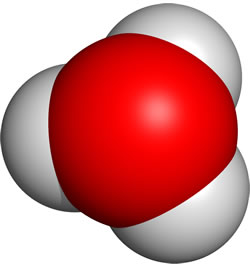GENERAL CHEMISTRY TOPICS
Hydronium ion
Hydronium ion and other acidic species in pure water. H+(aq) is used as an abbreviation for hydronium.
An exceedingly important feature of water is that it can play the role of an acid or a base, in terms of the Brønsted-Lowry acid-base definitions. Both roles of water can be combined into a single equation (shown below) representing a complete Brønsted-Lowry acid-base reaction. This reaction can be described as an autoionization of water. Note that in some sources, this is called autoprotolysis, or autodissociation).

The products of this reaction are the two polyatomic ions, hydronium ion (H3O+), and hydroxide ion (OH−). This ionic equation is commonly abbreviated by chemists by elimination of a water molecule and letting H+(aq) represent hydronium ion:
H2O(l) → H+(aq) + OH−(aq)
For the sake of convenience, the H+(aq) abbreviation for hydronium ion is widely used. To be clear, H+ itself would be just an isolated proton (for 1H) so it is important to note that no such species exists in aqueous solution. The species formed by H+ transferred to a water molecule, H3O+ (the structure of which is illustrated at lower right) best represents the acidic species in water.

In cases where strong acids are created by reaction with water, such as when hydrogen chloride, HCl(g) dissolves in water, it reacts nearly completely with water according to the chemical equation:
HCl(aq) + H2O(l) → H3O+(aq) + Cl−(aq)
The common abbreviated form of this chemical equation uses H+(aq) in place of hydronium, and drops the water reactant from the equation:
HCl(aq) → H+(aq) + Cl−(aq)
When hydrochloric acid is written as HCl(aq), it is assumed to represent in ionic form H+(aq) and Cl−(aq) (or H3O+(aq) and Cl−(aq) in non-abbreviated form) as hydrochloric acid is a strong electrolyte.
We can quantify water's small tendency to autoionize by defining a special type of equilibrium constant called Kw and assigning an experimentally determined value to it.
Kw = [ H+ ][ OH − ] = 1.0 × 10−14 (at 25°C).
Note that this is the equilibrium constant expression that we would write for the chemical equation representing the autoionization reaction of water, considering the concentration of water as a constant. The very small value for Kw reflects the very weak propensity of water to autodissociate.